Project Change, Risk and Opportunities Management: Integration Plan
VerifiedAdded on 2022/11/25
|23
|5733
|71
Project
AI Summary
This project report analyzes the merger of Northern Bank and Southern Bank, focusing on the integration plan and its impact on stakeholders. The report details the strategic approach, including SWOT and SMART analyses, and the challenges encountered, such as cultural differences and resistance to change. It examines stakeholder analysis, power-interest evaluations, and communication plans. The project reviews the decisions made regarding HR practices, employee layoffs, product portfolios, loan approval processes, IT systems, and the branch network. The report also discusses the governance framework, benefits of governance, and lessons learned during the integration process, providing recommendations for improvement. The report highlights the internal and external drivers of the merger and the key risks associated with the integration plan. It includes a detailed stakeholder analysis, outlining the influence networks and communication plans used to manage the merger's stakeholders. The report concludes with recommendations based on the challenges faced and lessons learned throughout the six-month integration period.
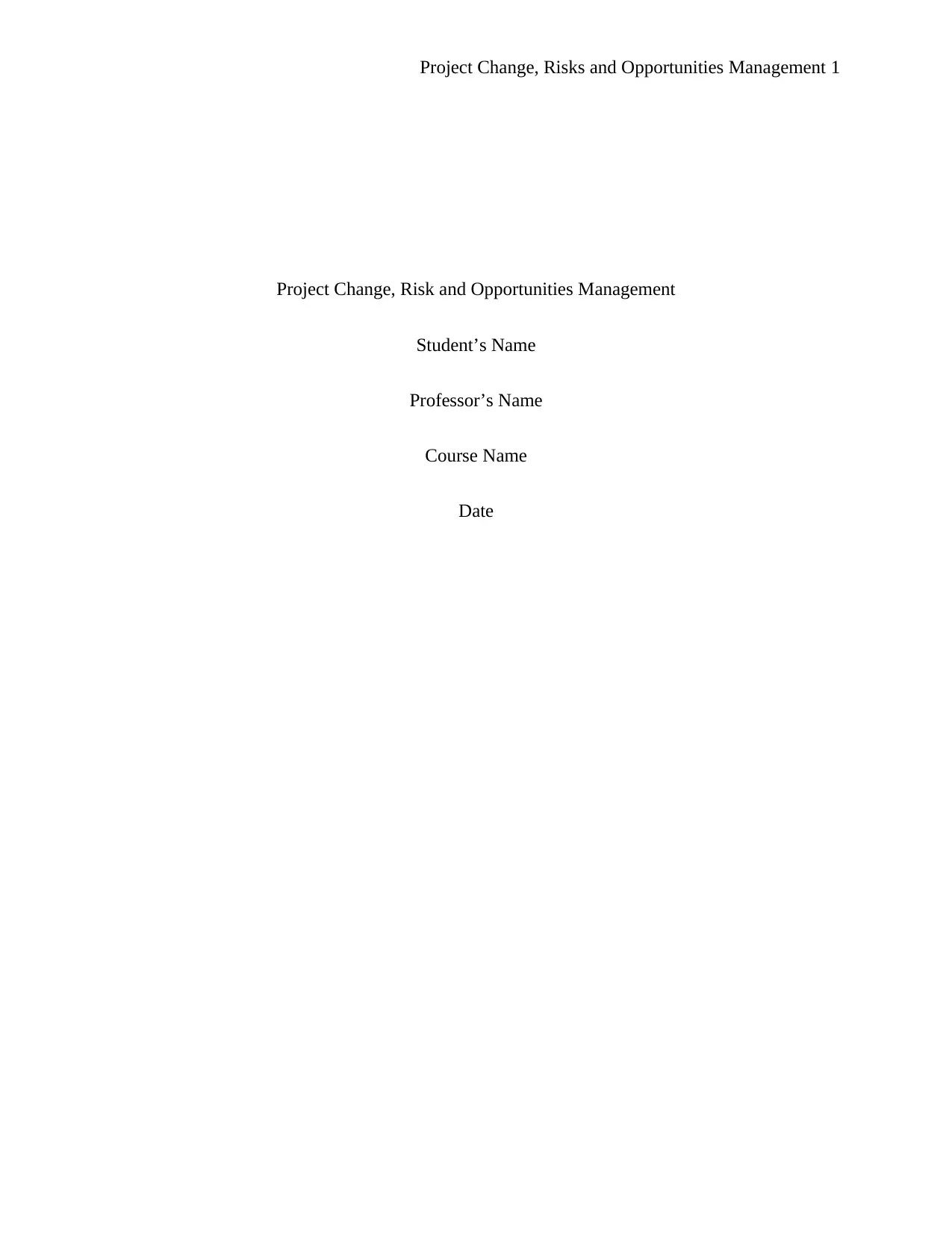
Project Change, Risks and Opportunities Management 1
Project Change, Risk and Opportunities Management
Student’s Name
Professor’s Name
Course Name
Date
Project Change, Risk and Opportunities Management
Student’s Name
Professor’s Name
Course Name
Date
Paraphrase This Document
Need a fresh take? Get an instant paraphrase of this document with our AI Paraphraser
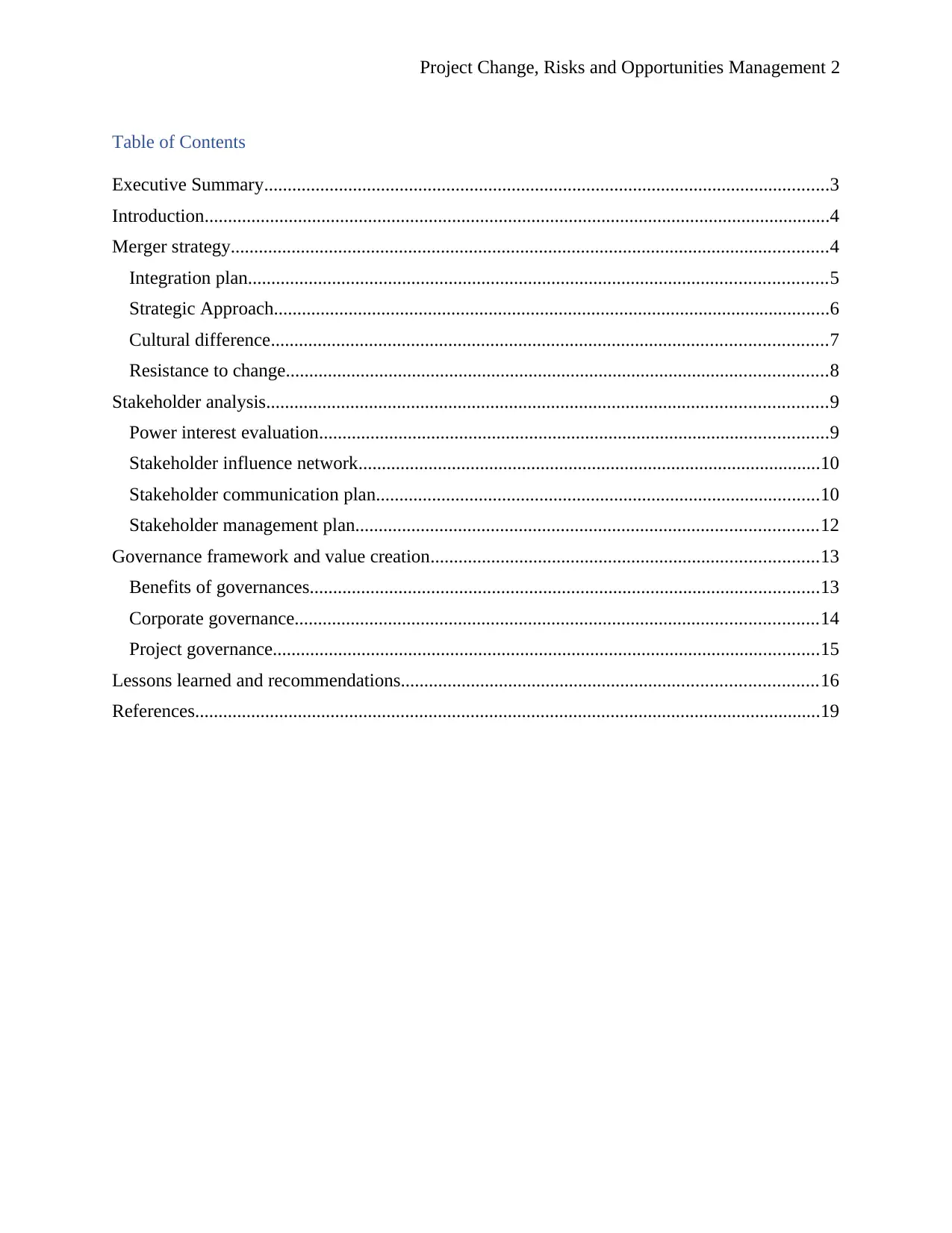
Project Change, Risks and Opportunities Management 2
Table of Contents
Executive Summary.........................................................................................................................3
Introduction......................................................................................................................................4
Merger strategy................................................................................................................................4
Integration plan............................................................................................................................5
Strategic Approach.......................................................................................................................6
Cultural difference.......................................................................................................................7
Resistance to change....................................................................................................................8
Stakeholder analysis........................................................................................................................9
Power interest evaluation.............................................................................................................9
Stakeholder influence network...................................................................................................10
Stakeholder communication plan...............................................................................................10
Stakeholder management plan...................................................................................................12
Governance framework and value creation...................................................................................13
Benefits of governances.............................................................................................................13
Corporate governance................................................................................................................14
Project governance.....................................................................................................................15
Lessons learned and recommendations.........................................................................................16
References......................................................................................................................................19
Table of Contents
Executive Summary.........................................................................................................................3
Introduction......................................................................................................................................4
Merger strategy................................................................................................................................4
Integration plan............................................................................................................................5
Strategic Approach.......................................................................................................................6
Cultural difference.......................................................................................................................7
Resistance to change....................................................................................................................8
Stakeholder analysis........................................................................................................................9
Power interest evaluation.............................................................................................................9
Stakeholder influence network...................................................................................................10
Stakeholder communication plan...............................................................................................10
Stakeholder management plan...................................................................................................12
Governance framework and value creation...................................................................................13
Benefits of governances.............................................................................................................13
Corporate governance................................................................................................................14
Project governance.....................................................................................................................15
Lessons learned and recommendations.........................................................................................16
References......................................................................................................................................19
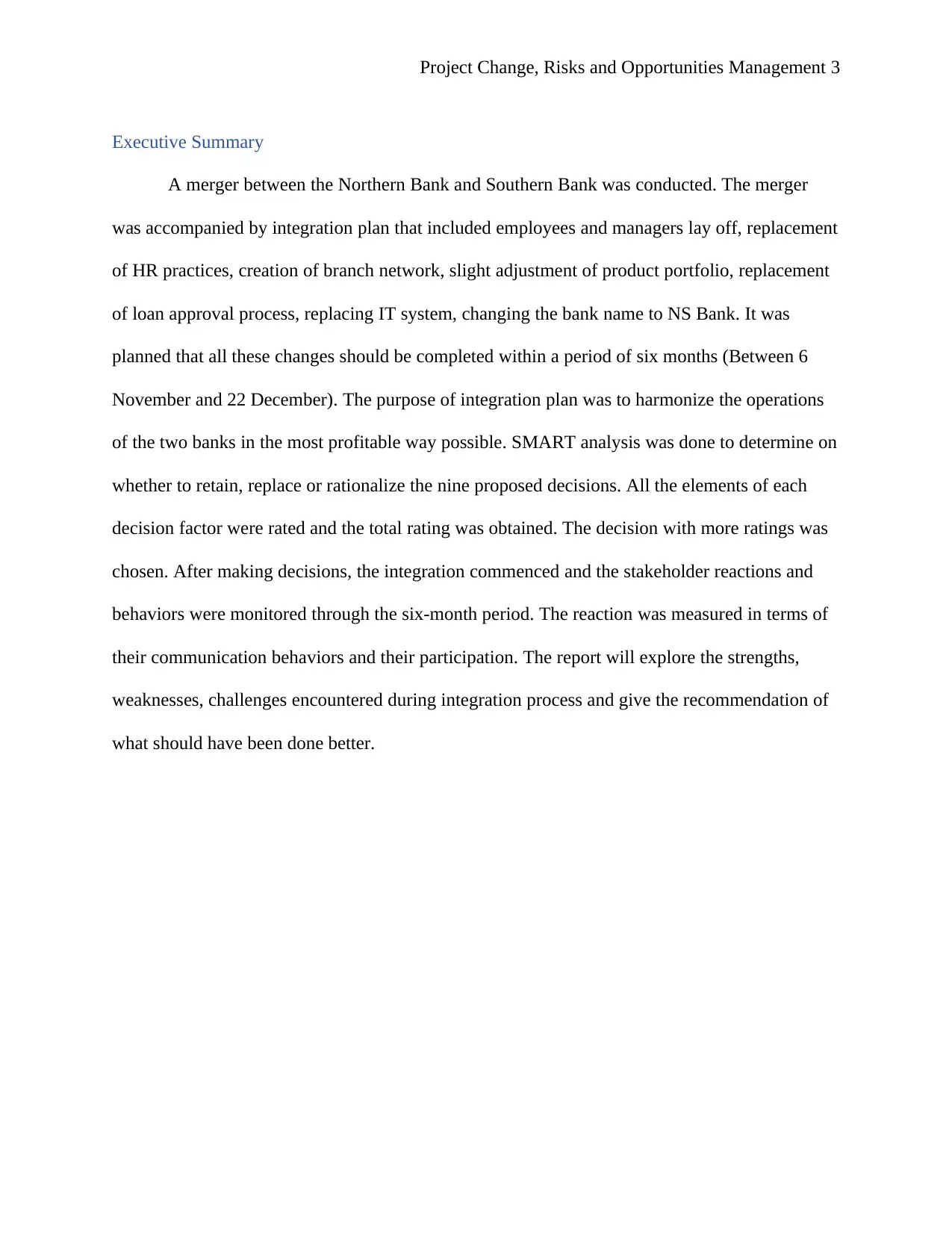
Project Change, Risks and Opportunities Management 3
Executive Summary
A merger between the Northern Bank and Southern Bank was conducted. The merger
was accompanied by integration plan that included employees and managers lay off, replacement
of HR practices, creation of branch network, slight adjustment of product portfolio, replacement
of loan approval process, replacing IT system, changing the bank name to NS Bank. It was
planned that all these changes should be completed within a period of six months (Between 6
November and 22 December). The purpose of integration plan was to harmonize the operations
of the two banks in the most profitable way possible. SMART analysis was done to determine on
whether to retain, replace or rationalize the nine proposed decisions. All the elements of each
decision factor were rated and the total rating was obtained. The decision with more ratings was
chosen. After making decisions, the integration commenced and the stakeholder reactions and
behaviors were monitored through the six-month period. The reaction was measured in terms of
their communication behaviors and their participation. The report will explore the strengths,
weaknesses, challenges encountered during integration process and give the recommendation of
what should have been done better.
Executive Summary
A merger between the Northern Bank and Southern Bank was conducted. The merger
was accompanied by integration plan that included employees and managers lay off, replacement
of HR practices, creation of branch network, slight adjustment of product portfolio, replacement
of loan approval process, replacing IT system, changing the bank name to NS Bank. It was
planned that all these changes should be completed within a period of six months (Between 6
November and 22 December). The purpose of integration plan was to harmonize the operations
of the two banks in the most profitable way possible. SMART analysis was done to determine on
whether to retain, replace or rationalize the nine proposed decisions. All the elements of each
decision factor were rated and the total rating was obtained. The decision with more ratings was
chosen. After making decisions, the integration commenced and the stakeholder reactions and
behaviors were monitored through the six-month period. The reaction was measured in terms of
their communication behaviors and their participation. The report will explore the strengths,
weaknesses, challenges encountered during integration process and give the recommendation of
what should have been done better.
⊘ This is a preview!⊘
Do you want full access?
Subscribe today to unlock all pages.

Trusted by 1+ million students worldwide

Project Change, Risks and Opportunities Management 4
Introduction
Project focuses on the human reactions experienced due to a series of integration options
that were carried out during the process of integration of Northern Bank with the newly acquired
Southern Bank. The move to integrate the two banks was taken based on the prediction that
merging the different banks will generate equity value for the Northern Bank. The idea for
merger was proposed by the CEO of Southern Bank and was supported by the CEO of the
Northern Bank. The merger process involved both the internal and external stakeholders. The
internal stakeholders were led by the CEOs for the two banks. The two CEOs shared almost
similar backgrounds and experiences. Another crucial stakeholder is employees. They comprised
Northern Bank employees and Southern bank RETAINED employees. The external stakeholders
comprised of fund director of sunrise pension fund, CEO of people power and state
representative of American Banking Authority. Based on stakeholder mapping, there was four
categories of stakeholders, which included key players, context setters, subjects and the crowd.
The move to merge was prompted by a number of drivers. For example, the previous
merger of EASTERN and WESTERN BANK was considered a significant threat to the Northern
and Southern bank and merging was the only best option for the two banks. There were also
external and internal drivers. The external key drivers included the need for sustainability
competitive advantages, the need to increase profitability, and the need to expand the market.
The internal drivers included the need to incorporate best practices from the two banks.
Merger strategy
Introduction
Project focuses on the human reactions experienced due to a series of integration options
that were carried out during the process of integration of Northern Bank with the newly acquired
Southern Bank. The move to integrate the two banks was taken based on the prediction that
merging the different banks will generate equity value for the Northern Bank. The idea for
merger was proposed by the CEO of Southern Bank and was supported by the CEO of the
Northern Bank. The merger process involved both the internal and external stakeholders. The
internal stakeholders were led by the CEOs for the two banks. The two CEOs shared almost
similar backgrounds and experiences. Another crucial stakeholder is employees. They comprised
Northern Bank employees and Southern bank RETAINED employees. The external stakeholders
comprised of fund director of sunrise pension fund, CEO of people power and state
representative of American Banking Authority. Based on stakeholder mapping, there was four
categories of stakeholders, which included key players, context setters, subjects and the crowd.
The move to merge was prompted by a number of drivers. For example, the previous
merger of EASTERN and WESTERN BANK was considered a significant threat to the Northern
and Southern bank and merging was the only best option for the two banks. There were also
external and internal drivers. The external key drivers included the need for sustainability
competitive advantages, the need to increase profitability, and the need to expand the market.
The internal drivers included the need to incorporate best practices from the two banks.
Merger strategy
Paraphrase This Document
Need a fresh take? Get an instant paraphrase of this document with our AI Paraphraser
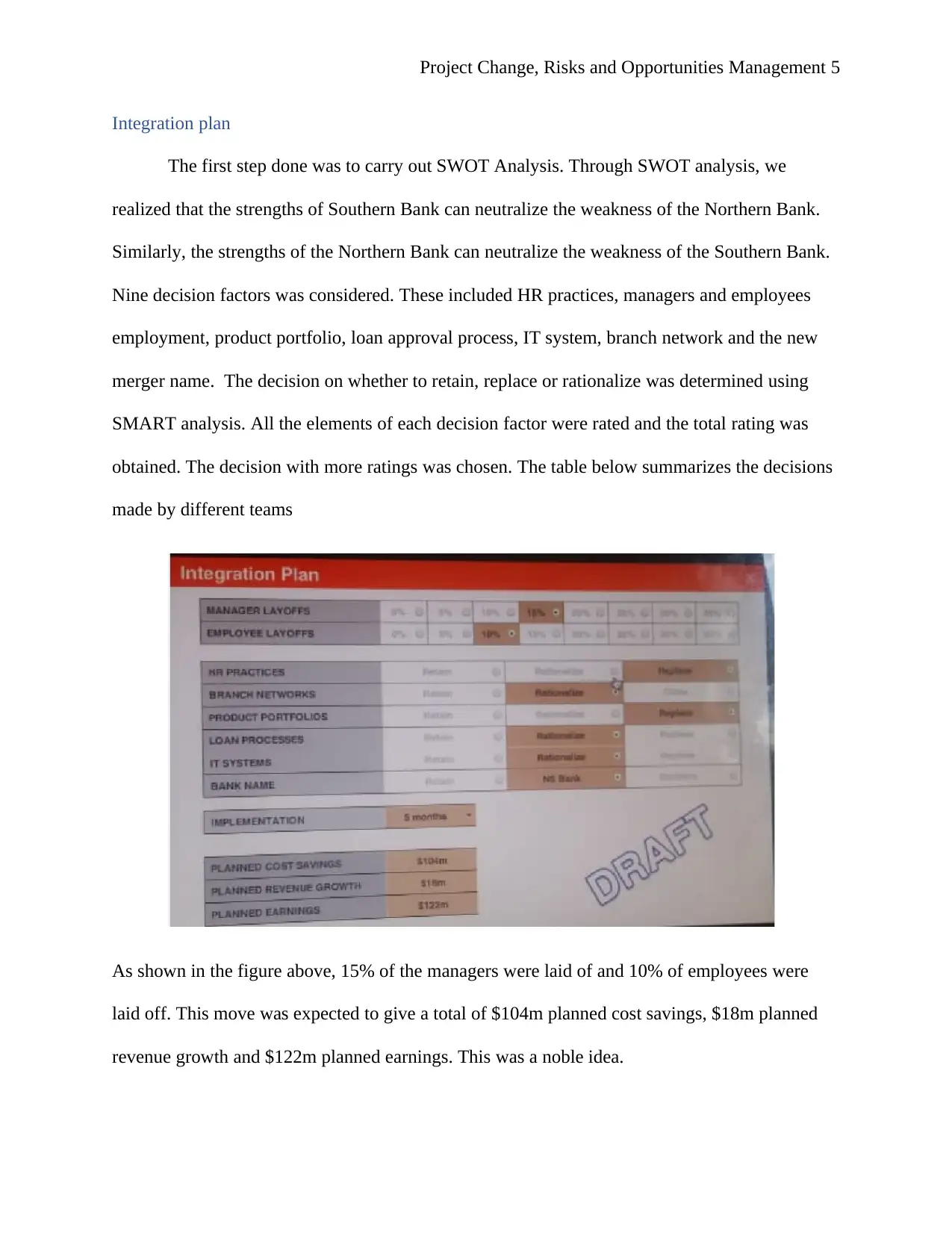
Project Change, Risks and Opportunities Management 5
Integration plan
The first step done was to carry out SWOT Analysis. Through SWOT analysis, we
realized that the strengths of Southern Bank can neutralize the weakness of the Northern Bank.
Similarly, the strengths of the Northern Bank can neutralize the weakness of the Southern Bank.
Nine decision factors was considered. These included HR practices, managers and employees
employment, product portfolio, loan approval process, IT system, branch network and the new
merger name. The decision on whether to retain, replace or rationalize was determined using
SMART analysis. All the elements of each decision factor were rated and the total rating was
obtained. The decision with more ratings was chosen. The table below summarizes the decisions
made by different teams
As shown in the figure above, 15% of the managers were laid of and 10% of employees were
laid off. This move was expected to give a total of $104m planned cost savings, $18m planned
revenue growth and $122m planned earnings. This was a noble idea.
Integration plan
The first step done was to carry out SWOT Analysis. Through SWOT analysis, we
realized that the strengths of Southern Bank can neutralize the weakness of the Northern Bank.
Similarly, the strengths of the Northern Bank can neutralize the weakness of the Southern Bank.
Nine decision factors was considered. These included HR practices, managers and employees
employment, product portfolio, loan approval process, IT system, branch network and the new
merger name. The decision on whether to retain, replace or rationalize was determined using
SMART analysis. All the elements of each decision factor were rated and the total rating was
obtained. The decision with more ratings was chosen. The table below summarizes the decisions
made by different teams
As shown in the figure above, 15% of the managers were laid of and 10% of employees were
laid off. This move was expected to give a total of $104m planned cost savings, $18m planned
revenue growth and $122m planned earnings. This was a noble idea.
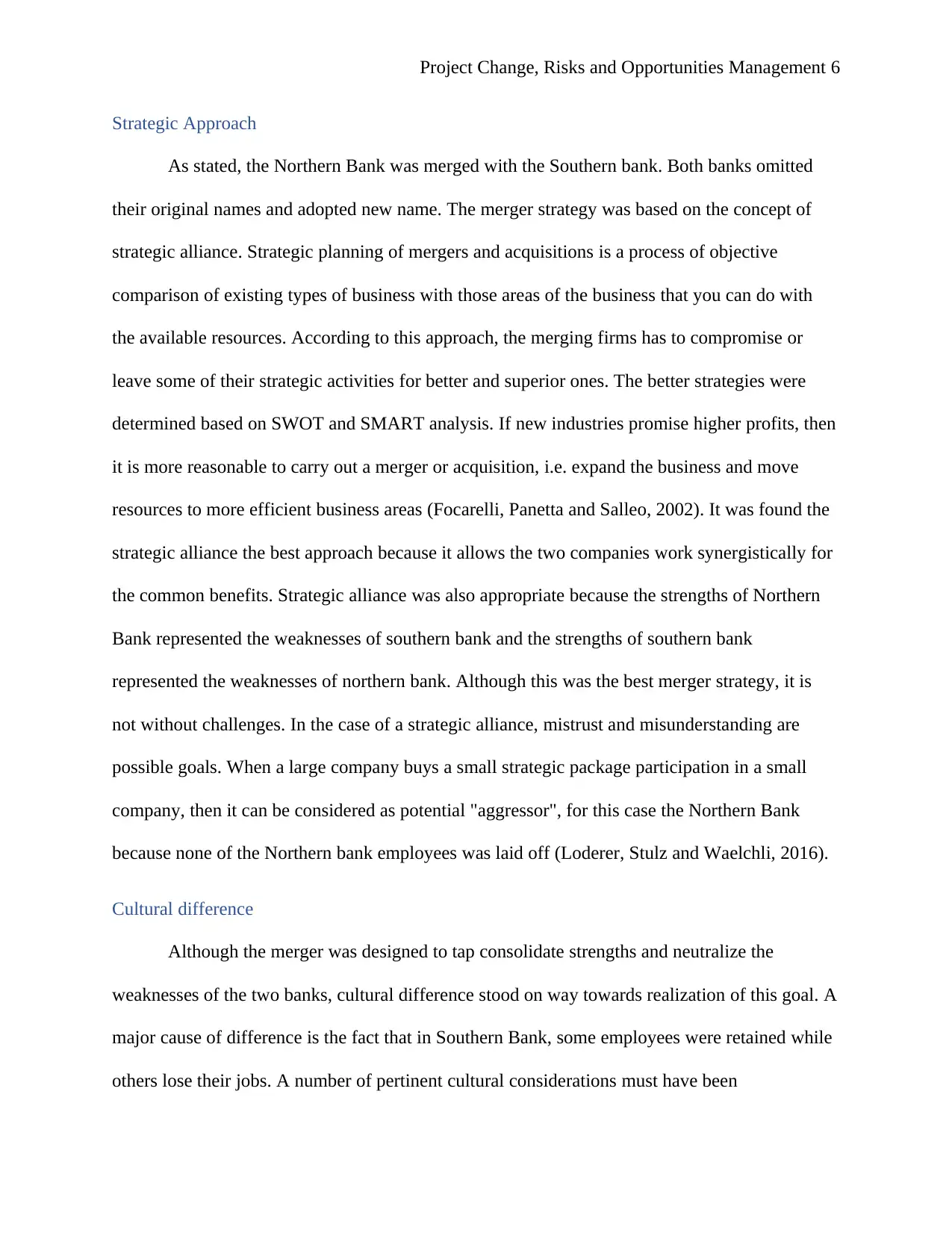
Project Change, Risks and Opportunities Management 6
Strategic Approach
As stated, the Northern Bank was merged with the Southern bank. Both banks omitted
their original names and adopted new name. The merger strategy was based on the concept of
strategic alliance. Strategic planning of mergers and acquisitions is a process of objective
comparison of existing types of business with those areas of the business that you can do with
the available resources. According to this approach, the merging firms has to compromise or
leave some of their strategic activities for better and superior ones. The better strategies were
determined based on SWOT and SMART analysis. If new industries promise higher profits, then
it is more reasonable to carry out a merger or acquisition, i.e. expand the business and move
resources to more efficient business areas (Focarelli, Panetta and Salleo, 2002). It was found the
strategic alliance the best approach because it allows the two companies work synergistically for
the common benefits. Strategic alliance was also appropriate because the strengths of Northern
Bank represented the weaknesses of southern bank and the strengths of southern bank
represented the weaknesses of northern bank. Although this was the best merger strategy, it is
not without challenges. In the case of a strategic alliance, mistrust and misunderstanding are
possible goals. When a large company buys a small strategic package participation in a small
company, then it can be considered as potential "aggressor", for this case the Northern Bank
because none of the Northern bank employees was laid off (Loderer, Stulz and Waelchli, 2016).
Cultural difference
Although the merger was designed to tap consolidate strengths and neutralize the
weaknesses of the two banks, cultural difference stood on way towards realization of this goal. A
major cause of difference is the fact that in Southern Bank, some employees were retained while
others lose their jobs. A number of pertinent cultural considerations must have been
Strategic Approach
As stated, the Northern Bank was merged with the Southern bank. Both banks omitted
their original names and adopted new name. The merger strategy was based on the concept of
strategic alliance. Strategic planning of mergers and acquisitions is a process of objective
comparison of existing types of business with those areas of the business that you can do with
the available resources. According to this approach, the merging firms has to compromise or
leave some of their strategic activities for better and superior ones. The better strategies were
determined based on SWOT and SMART analysis. If new industries promise higher profits, then
it is more reasonable to carry out a merger or acquisition, i.e. expand the business and move
resources to more efficient business areas (Focarelli, Panetta and Salleo, 2002). It was found the
strategic alliance the best approach because it allows the two companies work synergistically for
the common benefits. Strategic alliance was also appropriate because the strengths of Northern
Bank represented the weaknesses of southern bank and the strengths of southern bank
represented the weaknesses of northern bank. Although this was the best merger strategy, it is
not without challenges. In the case of a strategic alliance, mistrust and misunderstanding are
possible goals. When a large company buys a small strategic package participation in a small
company, then it can be considered as potential "aggressor", for this case the Northern Bank
because none of the Northern bank employees was laid off (Loderer, Stulz and Waelchli, 2016).
Cultural difference
Although the merger was designed to tap consolidate strengths and neutralize the
weaknesses of the two banks, cultural difference stood on way towards realization of this goal. A
major cause of difference is the fact that in Southern Bank, some employees were retained while
others lose their jobs. A number of pertinent cultural considerations must have been
⊘ This is a preview!⊘
Do you want full access?
Subscribe today to unlock all pages.

Trusted by 1+ million students worldwide
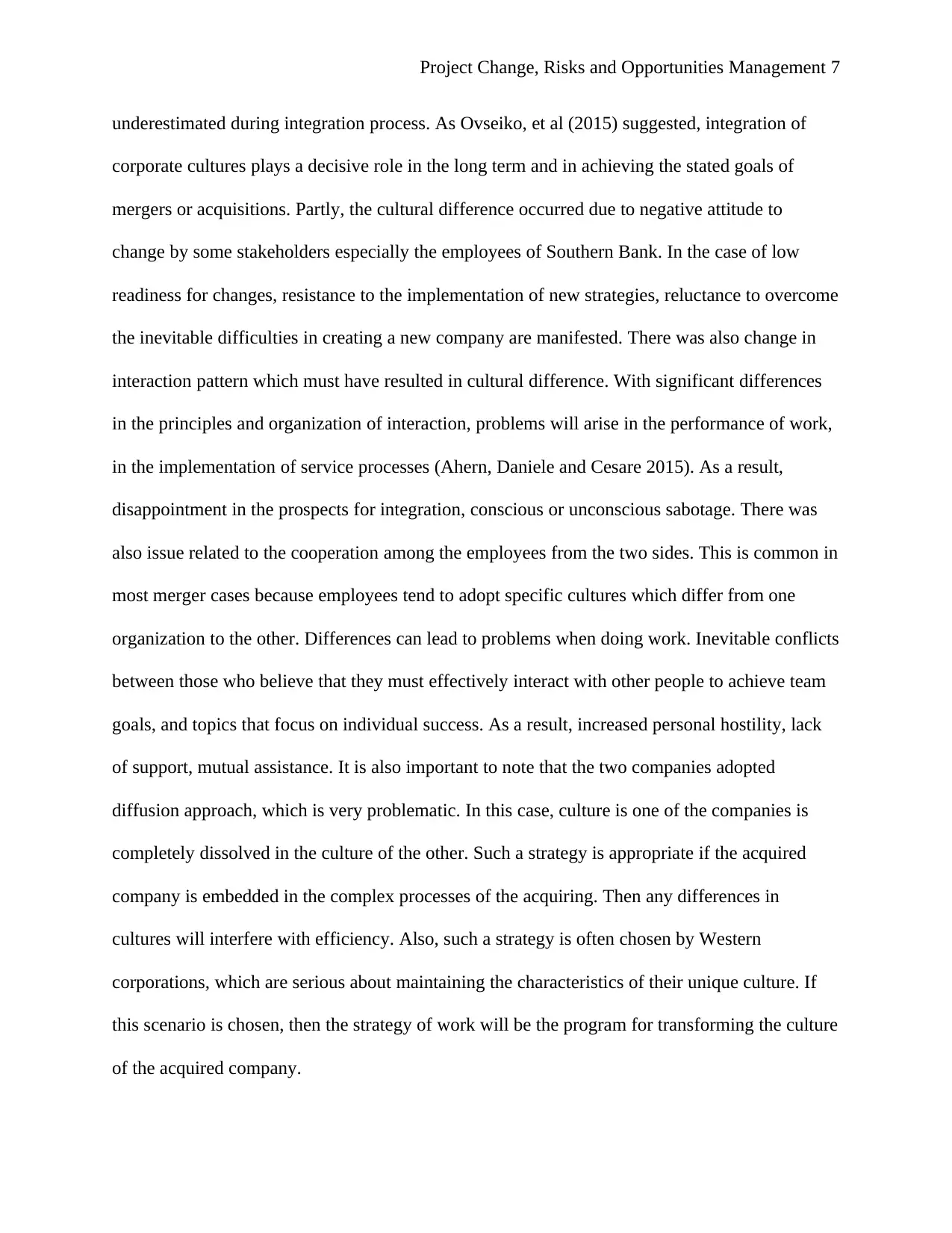
Project Change, Risks and Opportunities Management 7
underestimated during integration process. As Ovseiko, et al (2015) suggested, integration of
corporate cultures plays a decisive role in the long term and in achieving the stated goals of
mergers or acquisitions. Partly, the cultural difference occurred due to negative attitude to
change by some stakeholders especially the employees of Southern Bank. In the case of low
readiness for changes, resistance to the implementation of new strategies, reluctance to overcome
the inevitable difficulties in creating a new company are manifested. There was also change in
interaction pattern which must have resulted in cultural difference. With significant differences
in the principles and organization of interaction, problems will arise in the performance of work,
in the implementation of service processes (Ahern, Daniele and Cesare 2015). As a result,
disappointment in the prospects for integration, conscious or unconscious sabotage. There was
also issue related to the cooperation among the employees from the two sides. This is common in
most merger cases because employees tend to adopt specific cultures which differ from one
organization to the other. Differences can lead to problems when doing work. Inevitable conflicts
between those who believe that they must effectively interact with other people to achieve team
goals, and topics that focus on individual success. As a result, increased personal hostility, lack
of support, mutual assistance. It is also important to note that the two companies adopted
diffusion approach, which is very problematic. In this case, culture is one of the companies is
completely dissolved in the culture of the other. Such a strategy is appropriate if the acquired
company is embedded in the complex processes of the acquiring. Then any differences in
cultures will interfere with efficiency. Also, such a strategy is often chosen by Western
corporations, which are serious about maintaining the characteristics of their unique culture. If
this scenario is chosen, then the strategy of work will be the program for transforming the culture
of the acquired company.
underestimated during integration process. As Ovseiko, et al (2015) suggested, integration of
corporate cultures plays a decisive role in the long term and in achieving the stated goals of
mergers or acquisitions. Partly, the cultural difference occurred due to negative attitude to
change by some stakeholders especially the employees of Southern Bank. In the case of low
readiness for changes, resistance to the implementation of new strategies, reluctance to overcome
the inevitable difficulties in creating a new company are manifested. There was also change in
interaction pattern which must have resulted in cultural difference. With significant differences
in the principles and organization of interaction, problems will arise in the performance of work,
in the implementation of service processes (Ahern, Daniele and Cesare 2015). As a result,
disappointment in the prospects for integration, conscious or unconscious sabotage. There was
also issue related to the cooperation among the employees from the two sides. This is common in
most merger cases because employees tend to adopt specific cultures which differ from one
organization to the other. Differences can lead to problems when doing work. Inevitable conflicts
between those who believe that they must effectively interact with other people to achieve team
goals, and topics that focus on individual success. As a result, increased personal hostility, lack
of support, mutual assistance. It is also important to note that the two companies adopted
diffusion approach, which is very problematic. In this case, culture is one of the companies is
completely dissolved in the culture of the other. Such a strategy is appropriate if the acquired
company is embedded in the complex processes of the acquiring. Then any differences in
cultures will interfere with efficiency. Also, such a strategy is often chosen by Western
corporations, which are serious about maintaining the characteristics of their unique culture. If
this scenario is chosen, then the strategy of work will be the program for transforming the culture
of the acquired company.
Paraphrase This Document
Need a fresh take? Get an instant paraphrase of this document with our AI Paraphraser
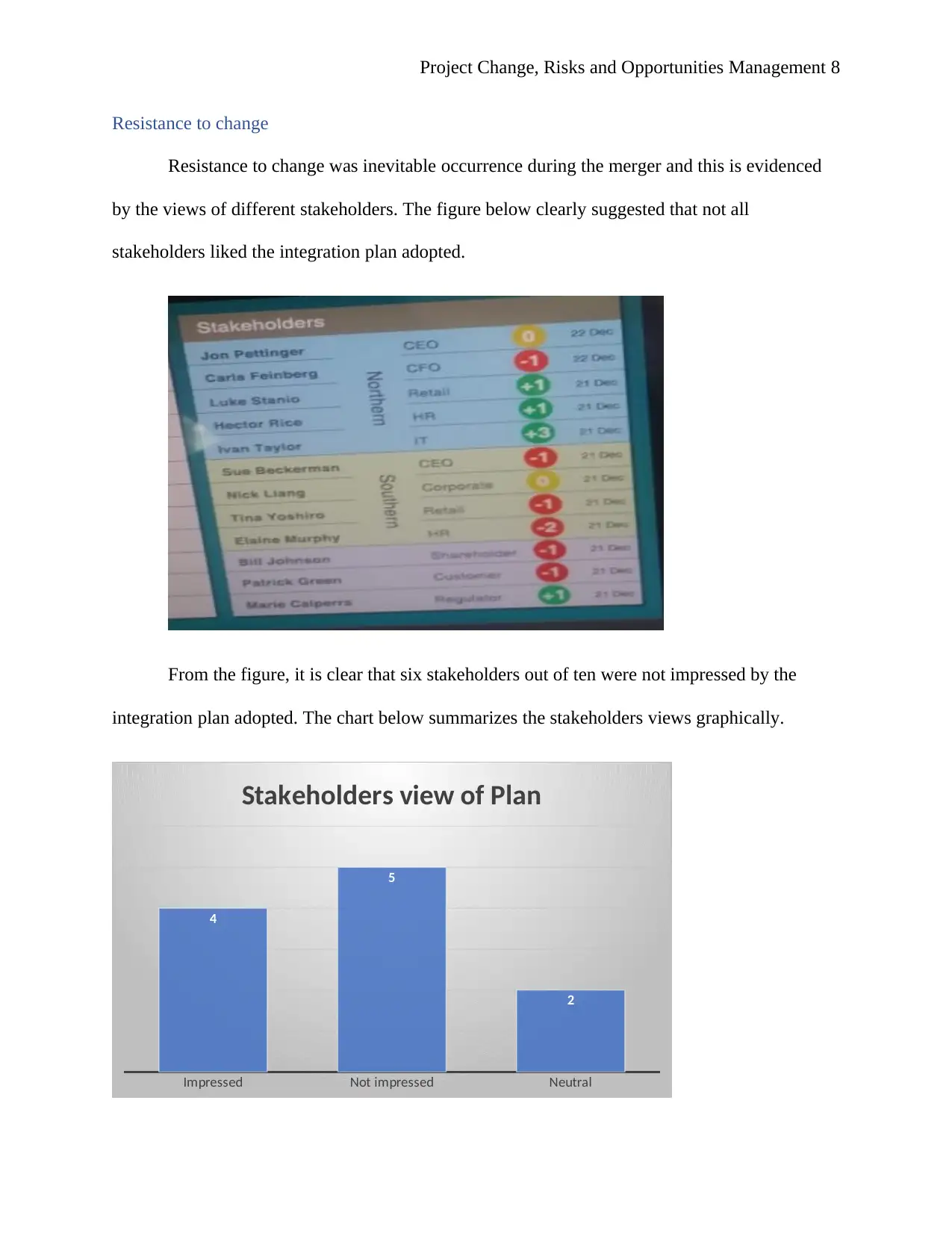
Project Change, Risks and Opportunities Management 8
Resistance to change
Resistance to change was inevitable occurrence during the merger and this is evidenced
by the views of different stakeholders. The figure below clearly suggested that not all
stakeholders liked the integration plan adopted.
From the figure, it is clear that six stakeholders out of ten were not impressed by the
integration plan adopted. The chart below summarizes the stakeholders views graphically.
Impressed Not impressed Neutral
4
5
2
Stakeholders view of Plan
Resistance to change
Resistance to change was inevitable occurrence during the merger and this is evidenced
by the views of different stakeholders. The figure below clearly suggested that not all
stakeholders liked the integration plan adopted.
From the figure, it is clear that six stakeholders out of ten were not impressed by the
integration plan adopted. The chart below summarizes the stakeholders views graphically.
Impressed Not impressed Neutral
4
5
2
Stakeholders view of Plan
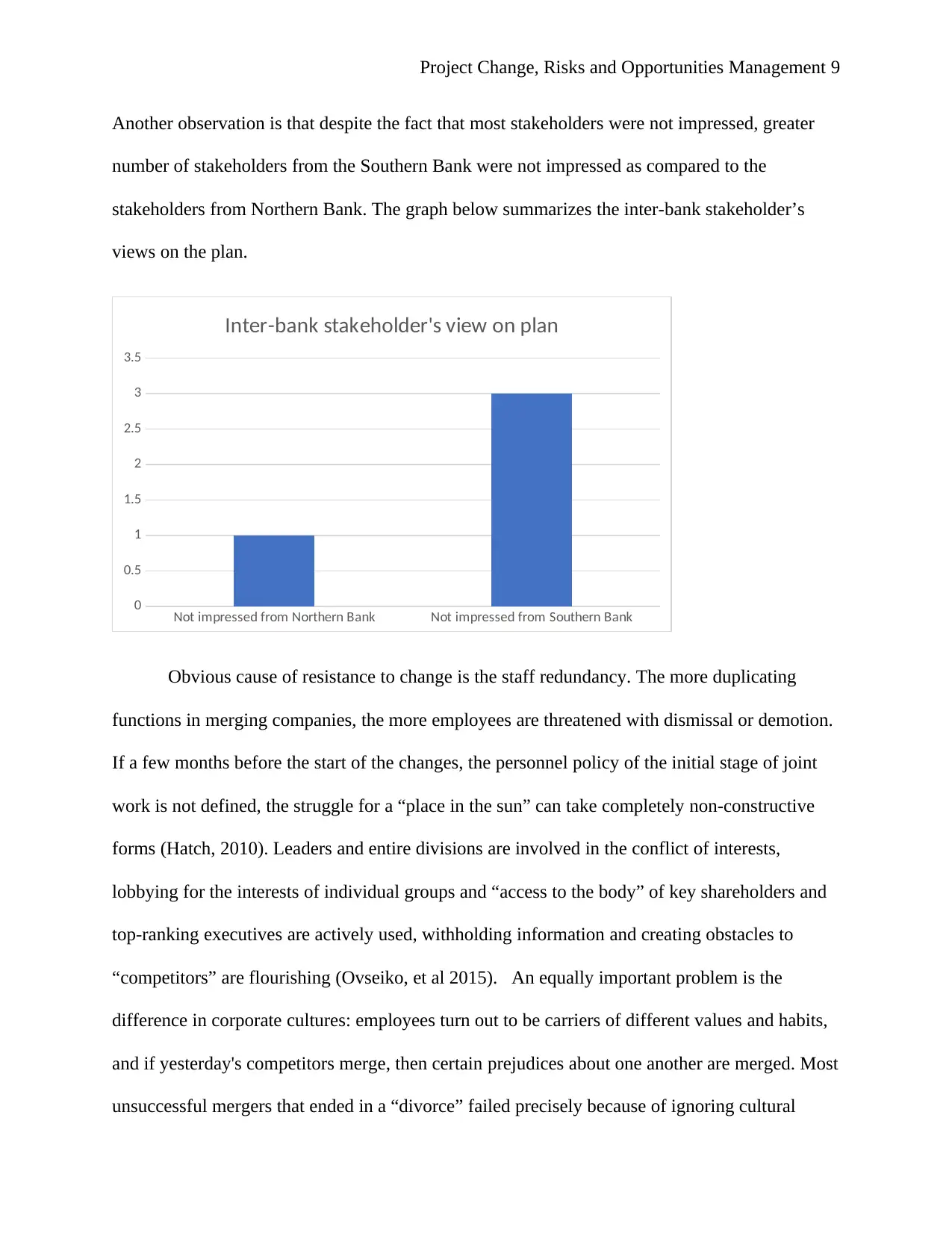
Project Change, Risks and Opportunities Management 9
Another observation is that despite the fact that most stakeholders were not impressed, greater
number of stakeholders from the Southern Bank were not impressed as compared to the
stakeholders from Northern Bank. The graph below summarizes the inter-bank stakeholder’s
views on the plan.
Not impressed from Northern Bank Not impressed from Southern Bank
0
0.5
1
1.5
2
2.5
3
3.5
Inter-bank stakeholder's view on plan
Obvious cause of resistance to change is the staff redundancy. The more duplicating
functions in merging companies, the more employees are threatened with dismissal or demotion.
If a few months before the start of the changes, the personnel policy of the initial stage of joint
work is not defined, the struggle for a “place in the sun” can take completely non-constructive
forms (Hatch, 2010). Leaders and entire divisions are involved in the conflict of interests,
lobbying for the interests of individual groups and “access to the body” of key shareholders and
top-ranking executives are actively used, withholding information and creating obstacles to
“competitors” are flourishing (Ovseiko, et al 2015). An equally important problem is the
difference in corporate cultures: employees turn out to be carriers of different values and habits,
and if yesterday's competitors merge, then certain prejudices about one another are merged. Most
unsuccessful mergers that ended in a “divorce” failed precisely because of ignoring cultural
Another observation is that despite the fact that most stakeholders were not impressed, greater
number of stakeholders from the Southern Bank were not impressed as compared to the
stakeholders from Northern Bank. The graph below summarizes the inter-bank stakeholder’s
views on the plan.
Not impressed from Northern Bank Not impressed from Southern Bank
0
0.5
1
1.5
2
2.5
3
3.5
Inter-bank stakeholder's view on plan
Obvious cause of resistance to change is the staff redundancy. The more duplicating
functions in merging companies, the more employees are threatened with dismissal or demotion.
If a few months before the start of the changes, the personnel policy of the initial stage of joint
work is not defined, the struggle for a “place in the sun” can take completely non-constructive
forms (Hatch, 2010). Leaders and entire divisions are involved in the conflict of interests,
lobbying for the interests of individual groups and “access to the body” of key shareholders and
top-ranking executives are actively used, withholding information and creating obstacles to
“competitors” are flourishing (Ovseiko, et al 2015). An equally important problem is the
difference in corporate cultures: employees turn out to be carriers of different values and habits,
and if yesterday's competitors merge, then certain prejudices about one another are merged. Most
unsuccessful mergers that ended in a “divorce” failed precisely because of ignoring cultural
⊘ This is a preview!⊘
Do you want full access?
Subscribe today to unlock all pages.

Trusted by 1+ million students worldwide
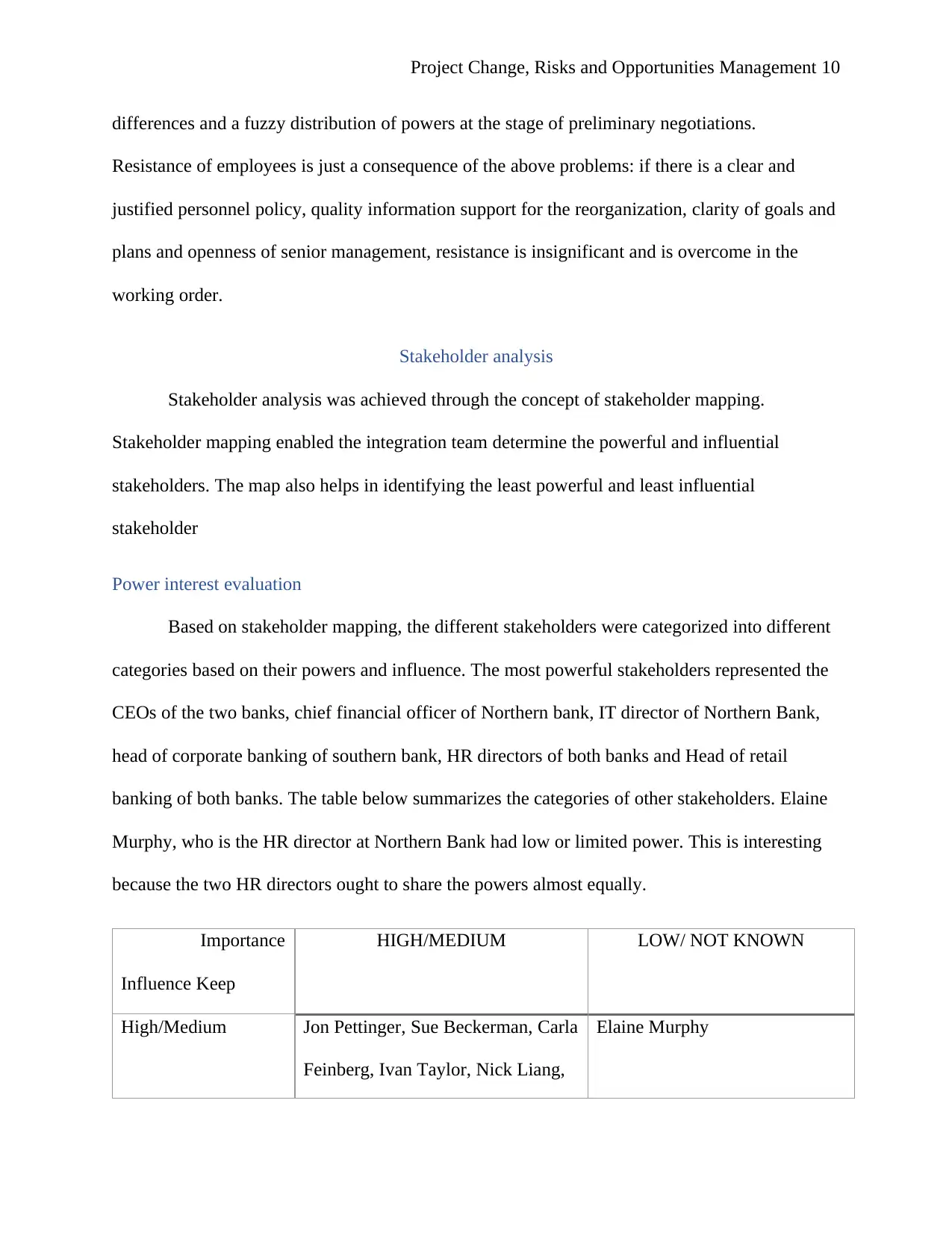
Project Change, Risks and Opportunities Management 10
differences and a fuzzy distribution of powers at the stage of preliminary negotiations.
Resistance of employees is just a consequence of the above problems: if there is a clear and
justified personnel policy, quality information support for the reorganization, clarity of goals and
plans and openness of senior management, resistance is insignificant and is overcome in the
working order.
Stakeholder analysis
Stakeholder analysis was achieved through the concept of stakeholder mapping.
Stakeholder mapping enabled the integration team determine the powerful and influential
stakeholders. The map also helps in identifying the least powerful and least influential
stakeholder
Power interest evaluation
Based on stakeholder mapping, the different stakeholders were categorized into different
categories based on their powers and influence. The most powerful stakeholders represented the
CEOs of the two banks, chief financial officer of Northern bank, IT director of Northern Bank,
head of corporate banking of southern bank, HR directors of both banks and Head of retail
banking of both banks. The table below summarizes the categories of other stakeholders. Elaine
Murphy, who is the HR director at Northern Bank had low or limited power. This is interesting
because the two HR directors ought to share the powers almost equally.
Importance
Influence Keep
HIGH/MEDIUM LOW/ NOT KNOWN
High/Medium Jon Pettinger, Sue Beckerman, Carla
Feinberg, Ivan Taylor, Nick Liang,
Elaine Murphy
differences and a fuzzy distribution of powers at the stage of preliminary negotiations.
Resistance of employees is just a consequence of the above problems: if there is a clear and
justified personnel policy, quality information support for the reorganization, clarity of goals and
plans and openness of senior management, resistance is insignificant and is overcome in the
working order.
Stakeholder analysis
Stakeholder analysis was achieved through the concept of stakeholder mapping.
Stakeholder mapping enabled the integration team determine the powerful and influential
stakeholders. The map also helps in identifying the least powerful and least influential
stakeholder
Power interest evaluation
Based on stakeholder mapping, the different stakeholders were categorized into different
categories based on their powers and influence. The most powerful stakeholders represented the
CEOs of the two banks, chief financial officer of Northern bank, IT director of Northern Bank,
head of corporate banking of southern bank, HR directors of both banks and Head of retail
banking of both banks. The table below summarizes the categories of other stakeholders. Elaine
Murphy, who is the HR director at Northern Bank had low or limited power. This is interesting
because the two HR directors ought to share the powers almost equally.
Importance
Influence Keep
HIGH/MEDIUM LOW/ NOT KNOWN
High/Medium Jon Pettinger, Sue Beckerman, Carla
Feinberg, Ivan Taylor, Nick Liang,
Elaine Murphy
Paraphrase This Document
Need a fresh take? Get an instant paraphrase of this document with our AI Paraphraser
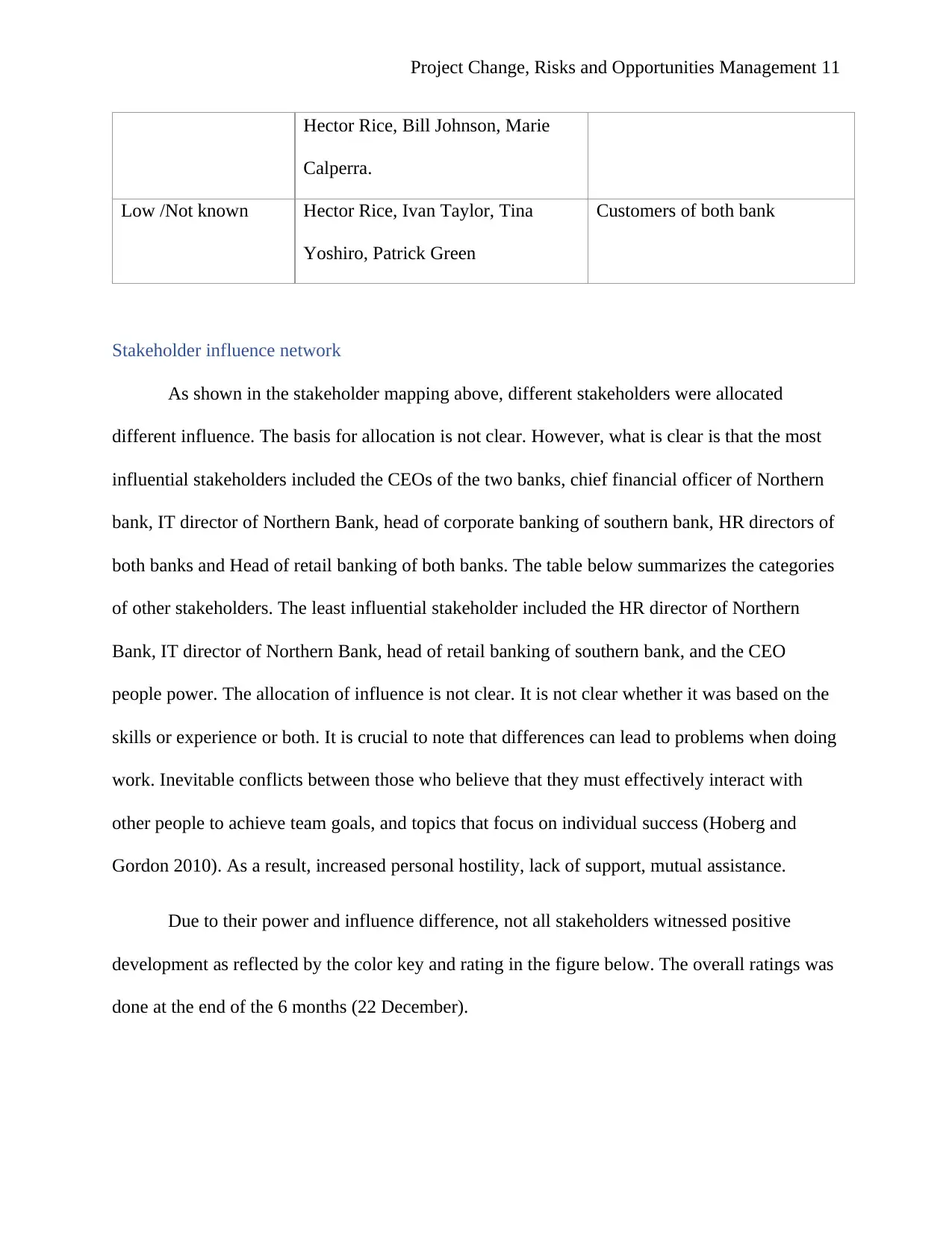
Project Change, Risks and Opportunities Management 11
Hector Rice, Bill Johnson, Marie
Calperra.
Low /Not known Hector Rice, Ivan Taylor, Tina
Yoshiro, Patrick Green
Customers of both bank
Stakeholder influence network
As shown in the stakeholder mapping above, different stakeholders were allocated
different influence. The basis for allocation is not clear. However, what is clear is that the most
influential stakeholders included the CEOs of the two banks, chief financial officer of Northern
bank, IT director of Northern Bank, head of corporate banking of southern bank, HR directors of
both banks and Head of retail banking of both banks. The table below summarizes the categories
of other stakeholders. The least influential stakeholder included the HR director of Northern
Bank, IT director of Northern Bank, head of retail banking of southern bank, and the CEO
people power. The allocation of influence is not clear. It is not clear whether it was based on the
skills or experience or both. It is crucial to note that differences can lead to problems when doing
work. Inevitable conflicts between those who believe that they must effectively interact with
other people to achieve team goals, and topics that focus on individual success (Hoberg and
Gordon 2010). As a result, increased personal hostility, lack of support, mutual assistance.
Due to their power and influence difference, not all stakeholders witnessed positive
development as reflected by the color key and rating in the figure below. The overall ratings was
done at the end of the 6 months (22 December).
Hector Rice, Bill Johnson, Marie
Calperra.
Low /Not known Hector Rice, Ivan Taylor, Tina
Yoshiro, Patrick Green
Customers of both bank
Stakeholder influence network
As shown in the stakeholder mapping above, different stakeholders were allocated
different influence. The basis for allocation is not clear. However, what is clear is that the most
influential stakeholders included the CEOs of the two banks, chief financial officer of Northern
bank, IT director of Northern Bank, head of corporate banking of southern bank, HR directors of
both banks and Head of retail banking of both banks. The table below summarizes the categories
of other stakeholders. The least influential stakeholder included the HR director of Northern
Bank, IT director of Northern Bank, head of retail banking of southern bank, and the CEO
people power. The allocation of influence is not clear. It is not clear whether it was based on the
skills or experience or both. It is crucial to note that differences can lead to problems when doing
work. Inevitable conflicts between those who believe that they must effectively interact with
other people to achieve team goals, and topics that focus on individual success (Hoberg and
Gordon 2010). As a result, increased personal hostility, lack of support, mutual assistance.
Due to their power and influence difference, not all stakeholders witnessed positive
development as reflected by the color key and rating in the figure below. The overall ratings was
done at the end of the 6 months (22 December).

Project Change, Risks and Opportunities Management 12
Stakeholder communication plan
Communication plan was measured by determining the frequency of communication for
each of the stakeholders. There were phone calls, emails, meetings, opinion requests, and weekly
consultations. It was determined that the consultation was frequent in week 1 to 4 and from
week 5 onwards, no more consultation was noted. In terms of frequency of communication, the
following table and chart was created based on the communication frequencies found.
Table1: Tabular representation of communication report
Phone Calls 47
Emails 16
Meetings 35
Opinion request 22
Consultation week 1-4 46
Consultation week 5-6 0
Stakeholder communication plan
Communication plan was measured by determining the frequency of communication for
each of the stakeholders. There were phone calls, emails, meetings, opinion requests, and weekly
consultations. It was determined that the consultation was frequent in week 1 to 4 and from
week 5 onwards, no more consultation was noted. In terms of frequency of communication, the
following table and chart was created based on the communication frequencies found.
Table1: Tabular representation of communication report
Phone Calls 47
Emails 16
Meetings 35
Opinion request 22
Consultation week 1-4 46
Consultation week 5-6 0
⊘ This is a preview!⊘
Do you want full access?
Subscribe today to unlock all pages.

Trusted by 1+ million students worldwide
1 out of 23
Your All-in-One AI-Powered Toolkit for Academic Success.
+13062052269
info@desklib.com
Available 24*7 on WhatsApp / Email
![[object Object]](/_next/static/media/star-bottom.7253800d.svg)
Unlock your academic potential
Copyright © 2020–2025 A2Z Services. All Rights Reserved. Developed and managed by ZUCOL.


